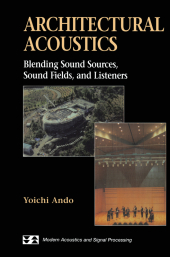 Neuerscheinungen 2012Stand: 2020-01-07 |
Schnellsuche
ISBN/Stichwort/Autor
|
Herderstraße 10
10625 Berlin
Tel.: 030 315 714 16
Fax 030 315 714 14
info@buchspektrum.de |

Yoichi Ando
Architectural Acoustics
Blending Sound Sources, Sound Fields, and Listeners
2012. xv, 252 S. 23 Tabellen. 235 mm
Verlag/Jahr: SPRINGER, BERLIN 2012
ISBN: 1-461-26838-9 (1461268389)
Neue ISBN: 978-1-461-26838-3 (9781461268383)
Preis und Lieferzeit: Bitte klicken
Proceeding from basic theory to design studies of concert and multiple purpose halls, the author introduces a remarkable seat selection system for the analysis of new and existing halls, and proposes a diagnostic system for testing the physical properties and calculating the psychological attributes at any seat after a hall is built. The book also presents a theory of subjective preferences, based on a model of the auditory cognitive system in the brain. Readers can thus follow the temporal and spatial values that may be associated with the left and right cerebral hemispheres in listening to music and speech, respectively, in a room. From the results of calculating subjective preference at each seat, for example, architects, musicians, and acoustical engineers concerned with the design and use of concert and multi-use halls may determine the best location to perform a certain type of music on the stage, as well as the best seats from which to listen.
1. Introduction.- 2. Short Historical Review for Acoustics in a Performing Space.- 3. Physical Properties of Source Signals and Sound Fields in a Room.- 3.1. Analyses of Source Signals.- 3.2. Autocorrelation Function of Piano Signal with Varying Performing Style.- 3.3. Sound Transmission from a Point Source to Binaural Entrances.- 3.4. Physical Factors of Sound Field.- 3.5. Simulation of Sound Field.- 4. Subjective Preference as an Overall Impression of the Sound Field.- 4.1. Subjective Preference of the Simple Sound Field.- 4.2. Orthogonal Properties of Acoustic Factors.- 4.3. Optimum Design Objectives.- 4.4. Theory of Calculating Scale Values of Subjective Preference.- 4.5. Examination of Subjective Preference in an Existing Hall.- 5. Human Hearing System.- 5.1. Physical Systems of Human Ears.- 5.2. Influence of Electro-Physiological Responses from Auditory Pathways and Human Cerebral Hemispheres Relating to Subjective Preference.- 5.3. Influence of the Continuous Brain Wave (CBW) on Subjective Preference.- 5.4. Auditory-Brain System: A Proposed Model.- 6. Important Subjective Attributes for the Sound Field, Based on the Model.- 6.1. Subjective Diffuseness and ASW in Relation to the IACC and/or theWIACC.- 6.2. Subjective Attributes of the Sound Fields with a Single Reflection in Relation to the ACF of the Source Signals.- 6.3. Loudness in Relation to the Effective Duration of the ACF.- 6.4. Speech Intelligibility and Clarity in Relation to the Temporal Factor (TF) and the IACC.- 7. Subjective Effects of Sound Field on Performers.- 7.1. Subjective Preference of Performer for Sound Field on the Stage.- 7.2. Influence of the Music Program Selection on Performance.- 7.3. Selection of the Performing Position for Maximizing Listener´s Preference.- 8. Passive Control of Sound Field by Design.- 8.1. Control of the IACC by Side Walls.- 8.2. Control of the IACC by Ceilings.- 8.3. Influence of Diffusers on Walls and Ceilings.- 8.4. Reflectors near the Ceiling.- 8.5. Floor Structure and Seating.- 9. Individual Listener Subjective Preferences and Seat Selection.- 9.1. Individual Preference According to Orthogonal Factors.- 9.2. Effects of Lighting on Individual Subjective Preference.- 9.3. Inter-Individual Differences in Preference Judgments.- 9.4. Seat Selection System for Individual Listening.- 10. Case Studies of Acoustic Design.- 10.1. Concert Hall Design.- 10.2. Multiple-Purpose Auditoria.- 11. Acoustical Measurements of the Sound Fields in Rooms.- 11.1. Binaural Impulse Response.- 11.2. Reverberation Time.- 11.3. Measurement of Acoustic Factors at Each Seat in a Concert Hall.- 11.4. Recommended Method for the IACC Measurement.- 11.5. Physical Properties of a Forest as an Acoustic Space.- 12. Generalization to Physical Environmental Planning Theory.- 12.1. A Generalized Theory of Designing Physical Environments.- 12.2. Examples of Physical Environmental Planning.- Appendix I. Method of Factor Analysis.- Appendix II. Design of Electroacoustic Systems.- II.1. The IACC of a Two-Channel-Loudspeaker-Reproduction System.- II.2. A System of Controlling Temporal Factors.- Appendix III. Time-Variant Sound Fields: Variable-Delay Time of a Single Reflection.- References.- General Reading.- Glossary of Symbols.- Abbreviations.- Author Index.


